
Guests
- Eyal Weizmanfounder and director of Forensic Architecture, professor of spatial and visual cultures at Goldsmiths College at the University of London.
Our extended conversation with Eyal Weizman, a British Israeli architect born in Haifa who founded Forensic Architecture. He’s the author of several books, including Hollow Land: Israel’s Architecture of Occupation.
Transcript
AMY GOODMAN: This is Democracy Now!, democracynow.org, The War and Peace Report. I’m Amy Goodman, with Nermeen Shaikh, as we continue with Part 2 of our discussion with Eyal Weizman, the founder of Forensic Architecture.
NERMEEN SHAIKH: In Part 1 of our discussion, we looked at a report published by the research group Forensic Architecture, which counters Israel’s argument at the International Court of Justice that it followed humanitarian policies to safeguard civilian life in Gaza. South Africa argued in January before the ICJ that Israel was guilty of genocide during its war on Gaza. The report argues that what Israel says are humanitarian evacuations in Gaza actually amount to the forced displacement of Palestinians, which is a war crime.
AMY GOODMAN: For more, we continue in London with Eyal Weizman, a British Israeli architect who’s the founder of Forensic Architecture and professor of spatial and visual cultures at Goldsmiths College at the University of London. He’s the author of several books, including Hollow Land: Israel’s Architecture of Occupation and The Least of All Possible Evils: A Short History of Humanitarian Violence. He’s also a member of the Technology Advisory Board of the International Criminal Court and of the Center for Investigative Journalism.
Eyal, we thank you so much for staying with us.
EYAL WEIZMAN: Yeah.
NERMEEN SHAIKH: Eyal, I’d like to begin by talking a little bit more about the background of Forensic Architecture and how you came to do this work. You wrote a piece in 2019 called “Open Verification.” You say in the piece that “More than a decade ago, I would have found the idea of a forensic institute to be rather abhorrent,” you wrote. But you said that your position changed in “response to changes in the texture of our present and to the nature of contemporary conflict.” So, if you could, you know, elaborate on that? What changes are you referring to? And how does this particular form of research respond more appropriately to those changes?
EYAL WEIZMAN: Yeah. So, you know, I’d just say that I would have found it abhorrent, because, you know, coming from social movement, coming from left-wing organizing, the idea of forensics seems so state and police and the authority of an expert and everything that we were rebelling against, this kind of state-sanctioned truth. And, really, you know, one’s opinion is something that is changing historically, very slow.
For me, the first thing that really occurred to me that something like that might be necessary was an article that Edward Said wrote in the London Review of Books at the beginning of the — of what is called the Second Intifada. I think he published it in December 2000. And he said that we need counter-cartography of the occupation. He said something like, you know, Palestinians and their allies and their friends have given up on cartography, whereas the Israeli army, the Israeli state controls completely space and the spatial representation. That is to say that it’s the form of Israeli colonialism at the time, with both the violence against the environment, all these developments and settlements and roads and the divisions and the fracture of Palestine into thousands of little islands, each one put under siege as part of the Second Intifada, you know, those Area A, so-called, around Palestinian cities, were coming out, out of kind of Israeli total control of the geography. And the Palestinians and their friends lacked at the time, according to him, the tool to expose those violations and understanding that colonial violence is both violence against the environment, the violence against people, against property, against the land, but it’s also violence against the truth, because contemporary colonialism needs to operate in a media-saturated environment, in which there are — you know, there are a lot of challenges and in which, you know, state needs to argue itself, needs to legitimize itself, and that legitimacy could be taken away from it through several tools. So he called for Palestinian cartography of Palestinians and their friends to engage in counter-cartography.
And I was a very young architectural graduate and at the time was with a group of Palestinian researchers and B’Tselem, a human rights organization, and others. We decided to create, you know, what didn’t exist, what was a map of Israeli occupation during the Second Intifada. We were driving through an environment that was, you know, very fractured, very dangerous. There was shooting along the roads. We were measuring things. We were marking things on the map. And we produced a map showing how — demonstrating the architectural crime of Israeli settler colonialism, how on the drawing boards of architects people were designing things that their aim was not simply to serve the community, to build a settlement, but designed to generate harm towards Palestinians.
Then what happened was that around 2005, I believe, just as the map came, was published, cartography changed completely with the introduction of widely available satellite images. And counter-cartography, in Saidian terms — Said has already passed away by that moment — had to turn into counter-forensics, because a satellite image is a photograph, and videos of violations started circulating on social media. And we understood that architecture, building architectural models, is actually the only way to make sense of the huge multiplicities of videos, because the violation is never documented fully in one video. It’s all about the relation between videos, about if one video is photographed from the right to left, the other from left to right, the third one from above to below, and you need to understand not what’s happening in the frame, but within the frame. And we understood that building those evidentiary assemblages of testimonies, of videos, of physical traces need to happen within our actual models.
But that is not the only thing, that what we needed to do was to break the authority of a single expert and to start work with huge multidisciplinary collectives of Palestinians, you know, led always by the people with experience on the ground. And now the people that lead the work in Palestine is the Al-Haq Forensic Architecture Unit, a group of young Palestinian architects. They’re doing amazing work and have actually also produced with us the investigation into the targeted killing of Shireen Abu Akleh, the great Palestinian Al Jazeera journalist. So, the idea of open verification is doing away with a single expert, towards collaborative communities of practice that are bringing a multiperspectival reality, or weave together a case from multiple perspectives, from huge number of videos, huge number of testimonies, weaving together like a carpet the facts of violation.
NERMEEN SHAIKH: So, Eyal, if you could speak — I mean, obviously, Forensic Architecture has produced a large number of reports on Israel-Palestine. But you’ve also worked in very, very diverse and different areas, documenting, for example, the CIA’s extraordinary rendition program, the presence of covert military Russian troops in Ukraine in 2014, the use of chemical weapons by the Assad regime in Syria, as well as Russian airstrikes in Syria against an MSF hospital. If you could explain what the mechanisms are? Who are the people that you decide to work with? And how do you collate all the information required to make the case that your reports do?
EYAL WEIZMAN: Yeah. So, we don’t typically work neither like journalists or like typical human rights group, because we work only through commissions. We enter the space of other people’s trauma only when invited. And this is because some of our cases, like the targeted killing of Shireen Abu Akleh, are so intimate, and you need to get medical reports, and you’re doing very close analysis and describe, you know, really, the sort of bodily consequences of extreme violence. You need to do it with respect. You need to do it with agreement.
And we are receiving now a huge number of requests from all over the world. I mean, if I go up now to the studio, if you’d come with me, you would see a large open-air, open-plan studio. You would see a lot of architects, creative types, filmmakers, journalists, etc., with the kind of buzz of a newsroom. And you would see different investigations from all over the world.
There’s a group now working even on an investigation on a German colonial-era genocide in today’s Namibia, then South West Africa, where we are helping. We were asked by Nama and Herero organizations to produce evidence as to the location of concentration and extermination camps in the German colonial genocide of 1904 to 1908, and, you know, to find places of former cemeteries and villages of Nama and of Herero people, to build a case for reparation, for colonial-era reparations.
Now, you know, we’re using techniques that we could use them on something that happened yesterday. Yesterday, we just released an investigation on the attack, the new attack, the second attack, on the Al-Shifa Hospital, using testimonies and videos, trying to understand exactly what’s happening there, what buildings were taken by the Israeli occupation forces and where people were targeted.
And at the same time, a group next to it would work on a crime that happened 120 years ago. It is — the principle is the same in both of them, that state crimes are both a crime against people and things, and are crimes against the evidence. They’re crimes against the truth. And to build the truth is complicated. And you need partnerships. And in Namibia, it is partnership with oral historians, that our witnesses of the German colonial genocide are not direct eyewitnesses but people that transmit inherited testimonies. Our work on Shifa yesterday are with people, with phone calls with people that yesterday experienced things in and around that place. The principle is that you weave a case together, just like you build a building. You need foundations. You need doors, windows. You need to build it together from a huge multiplicity of elements. And a case comes together very slowly, only as a kind of collaborative endeavor.
When we say we’re a forensic agency, we are very insistent on always saying we exercise a form of counter-forensics. We never work for states. We never take state commission. We only investigate crimes by police forces, by militaries, by secret services. And also, we don’t work like traditional state forensics work. It’s not like we use the forensic techniques that the police have developed. We developed completely other ways of doing it and, you know, the collaborative dimension of our work, and the fact that we are working together with people at the forefront. The fact is that we are always politically and emotionally aligned when we enter, rather than try to feign a kind of neutral objectivity, is part of the essence of our work, and sometimes we have to fight for it.
Another very important aspect of our work is that very often when you exercise counter-forensics, you do not have access to the courts, or sometimes the courts are actually just becoming an instrument of domination. This we see very often in Palestine, but not only, that the legal system is part of the occupation itself and is not something, you know, outside of the conflict to appeal to. In this situation, we need to find alternative fora, or multiplicities of forum. And, in fact, what we do is that we mind the original meaning of the term “forensics.” In Latin, ”forensis” is the art of the forum. Traditionally, forensis is not to do with the law, it is to do with the public presentation of facts. And indeed, we try to establish alternative forums.
So, sometimes you would encounter — and I’m sure you have — our work in museums, because we — you know, the work is very visual, and some museum curators like to invite us to an exhibition. And then we will turn the gallery into a tribunal. And we’ve done that when we couldn’t find or we couldn’t enter the mechanism of — you know, the traditional mechanism of justice. In London, when we investigated the police murder of Mark Duggan, a very famous police murder case that led to the 2011 uprising and the huge repression of Black-led struggle in England, we had to present that case at the Institute of Contemporary Arts in London in an exhibition that was a collaboration with Tottenham Rights, an organization based around, you know, Black defense to police forces, Black resistance to British policing. We’ve done this exhibition together in which we showed the case.
And also, something that is very important, when you practice counter-forensics, the incident, the split-second incident, is always an entry point into the long threads of history. So we never leave it as a technical analysis of what happened in a split second. We always ask: How do you take an incident as a bundle of threads, and you can pull the historical, political threads out of this incident and connect it to the world that enabled that incident to take place, the world in which that incident was logical, so that you can make a political claim based on a split second? In a split-second police killing of a racialized person in London, you could see the history of empire, you could see the history of British policing against Black communities. And you need to just look at it and connect those dots to make a larger historical political claim with micropolitical analysis, the dive into what we call the molecular level of time. The molecular level of time becomes an entry point into a history of analysis of long durations.
AMY GOODMAN: Eyal, I wanted to switch gears a bit. We recently interviewed Masha Gessen, the Russian American writer who had done a piece for The New Yorker magazine comparing Gaza with the Warsaw Ghetto. They had done that just after it was announced they were winning the Hannah Arendt Award — very interesting — in Germany — very interesting, because Hannah Arendt was quite critical of Zionism. But when that piece came out and Masha was making their way to Germany, the award was pulled because of that comparison. And it went from an event of hundreds in an auditorium to someone’s backyard. We are seeing the cancellation of artists and authors and political intellectuals, public intellectuals in different places, but in Germany, it has particular resonance, of course.
So I wanted to ask you — Forensic Architecture has an office in Berlin. In a recent conversation about the crackdown on pro-Palestinian voices in Germany, many of whom are Jewish, you said, quote, “that the German state would actually classify who is a Jew, and what’s a legitimate Jewish position, and how Jews should react, is just beneath contempt.” So, you are an architect, born in Haifa, in Israel. You work in London now. You have offices all over, including Berlin. Explain what’s happening there, with the rise of the AfD, the right, and progressives who are taking on what Israel is doing in Gaza being cracked down on all over, their voices actually being canceled and silenced.
EYAL WEIZMAN: Absolutely. So, first of all, I’d say I have great admiration for Masha Gessen’s work. I mean, their essay has been really spot-on. And the response to that is despicable, particularly because the Germans have gone across the very — a threshold that they didn’t quite go through, and that is to target Jewish progressives, Jewish intellectual life in Germany right now. And it’s not only Masha Gessen. They have — recently, there’s been a vicious and ugly attack on Judith Butler. There’s been attacks on many other German Berlin-based Jewish Israeli artists, including also Adam Broomberg, Candice Breitz and others.
There’s been attack on us. We have been the target of a kind of a smear case, with direct accusations that Forensic Architecture is sponsoring or promoting antisemitism in Germany. I’ve been accused of antisemitism myself for my activism for the BDS, and this is principles of nonarmed resistance to Israeli occupation and other colonial practices, that I firmly believe in. And our exhibitions have been canceled in Germany. Lectures that our team members were invited to deliver, not on Gaza even, on police, on racialized police murder in other places, lectures about something else, completely different things, have been canceled. And it’s becoming very hard for us to fund our office in Germany right now.
It seems that they have crossed that threshold to actually confront Jewish intellectual life in Germany. I would say right now, since the Second World War, it is the most difficult time to be a Jewish intellectual, a progressive Jewish intellectual, in Germany, because the consensus and the viciousness of the attack, the driving us out, or attempt to drive us out, from Germany by not funding us and deplatforming us is incredible.
The reason for that is complex. It’s come from different — the conjunctions of different things. What is behind it is obviously German memory, culture, something that is very admirable, that has begun — began, you know, since after the Second World War, but that became more prominent in the ’80s and after German unification, that I do think that Germany has responsibility to protect Jewish communities and Jewish intellectual life in Germany. And that is something that is extremely important.
I think, however, that for Germany, now Israel has become a matter of faith. It’s almost like you’re experiencing a certain unexplainable political theology. Some people, some friends of mine, have explained it as the second sacrifice. You know, after, obviously, the origins of Christian tradition as around the first sacrifice, the crucification, the Holocaust is an event that defines the national identity and political theology in Germany to such extent that it becomes something that is out of the world, out of history. And when you say “out of history,” you cannot question or you cannot discuss whether there are colonial practices that were influencing the extermination and murder of Jews in Eastern Europe.
I experienced — as I told you, we’re working on Namibia, on the German colonial genocide in Namibia. Some of its practices, like concentration camp, extermination or the racial laws, there is continuity of stuff. The father of Goebbels was actually the first governor of German colonial South West Africa. There’s very good cases to say you need to look at the Holocaust in relation to colonial crime. If you say something like that, it’s almost like it’s sacrilegious.
To a certain extent, the Holocaust has become a religious faith, that is uncomparable, that is ahistorical, and that its lesson is completely monovalented. There’s one lesson from it. And that is the protection of Israel as the Staatsräson, as the reason for existing of the German state. The right of being of the German state is understood as the protection of Israel. And the protection of Israel means the protection and support of every Israeli policy. And therefore, you see German arming the Israeli genocidal machine in Gaza now as a reparation for their genocide.
And Germany silencing Jewish voices — of course, not only Jewish voices, Palestinian, people from the Global South, intellectuals, like my friend, Achille Mbembe, who was one of the first people to be targeted. But right now a third of the people that have been canceled and deplatformed in Germany are progressive Jews. That is a campaign that is — this is why I’m saying, being now in Germany, it is one of the darkest periods to be a German Jewish intellectual in Germany today.
And that is — and just like any article of faith, it has to go against everything that you see in front of your eyes; otherwise, it wouldn’t be faith. So, you could see the full destruction of Gaza, you could see it in front of your eyes — Germans see that in the news — but still would support Israel, still would justify it, still would compare October 7th to the Holocaust in a crass kind of like short circuit of history, and would still feel themselves completely entitled to attack and deplatform Jewish progressive voices, rather than what actually they should understand is that a huge part of Jewish progressive tradition comes from Germany.
In fact, they should be proud of the Jewish left-wing and progressive thinkers, like not only like Hannah Arendt, who, of course, was ambivalent about Zionism. At some other parts of her career, she was actually — she was a Zionist. But there’s Benjamin, and there are others. There’s Rosa Luxemburg. There is so many other voices there that would give Germans a pause and to think that German political and cultural life need to be varied. It needs to be an open conversation. And that is exactly what they need to promote, rather than lead, effectively, to our outward migration again from Germany because we cannot be platformed, because it’s difficult for us to get public funding, and because we’re being targeted in press without actually people taking our side and saying, “Stop this craziness, this mishegaas. Stop it.”
NERMEEN SHAIKH: Eyal Weizman, as part of that same conversation that was published in Granta in November, you spoke also of your own personal experience of October 7th, saying, quote, that following the attacks, you said, “I can’t deny that as the descendant of family of pogrom and Holocaust survivors the close-range killings of families were emotionally triggering. But the trauma I too experience can’t replace the responsibility of historical analysis,” you said. So, if you could elaborate on that, and also explain what was the effect of October 7th on you, on your family, your friends?
EYAL WEIZMAN: Yeah. October 7th is a very painful day to come back to. I think, you know, throughout the days, things were being clarified, of course. The first response that everyone that is concerned about the ongoing oppression of Palestinians, the occupation and the horrific result of the siege, when one is seeing Palestinians are breaking out, was support of Palestinian resistance against this, the mechanism of settler-colonial oppression. They’ve dismantled the walls and the control towers and the military bases. They’ve undertaken multiplicity of small attacks that actually managed to bring Israel to its knees during those hours.
And then reports from the settlements arrived and from the party, and things became emotionally difficult and morally difficult. I think that one can support the Palestinian right to resist, one can understand the reason and the context for October 7th as a legitimate act of resistance, and one can completely oppose the killing, the intentional killing, of Israeli civilians and other atrocities that are being clarified right now and have still not come fully to light, including the capture of Israeli civilians, that’s a violation of international law.
And, of course, if you read that piece, you know that I’ve written about it, that a close family member of mine was directly affected. But also, on the first day, when Forensic Architecture came back to the office, that was — this was a weekend. We came back immediately. We realized that a very close partner organization to ours, Ain Media, have lost member of staff or lost contact with several researchers. And what we were doing in the first days is really engaging in some kind of humanitarian version of our work. It wasn’t really, you know, kind of looking at cases, etc. We were looking for our partners. We were looking for our friends. You know, the people, our friends in Gaza, partner organization to us, were looking for them on the ground, and we were looking for them amongst hundreds of videos that we could find, trying to locate, trying to see whether the last place that they were seen, has there been bombings or attacks, Israeli attacks, on this area, until we realized the news were not good, and, with heavy hearts, reported on them.
And then, on the 22nd of October, the director of — Rushdi al-Sarraj, the director of this organization, Ain Media, an organization — as I say, you know, we’ve done together several investigations in Gaza; I mean, we were working together — he was killed in a targeted attack on his father’s home. His father is the mayor of Gaza. And then we started losing more and more friends. And the team here has got several Palestinians working with us, often from Gaza. And they were losing family members.
We were just trying to hold ourselves together at the most challenging moment in our history as an organization, both emotionally in terms of the amount of work we were asked to do, the amount of work we needed to do, the doubt whether doing analysis is at all making sense in face of such level of total destruction. What does it mean to analyze a targeted assassination here, a killing there, a bombing on a convoy, when entire neighborhoods are gone, places that we know, places where people are living that we care dearly about, where we had to be in contact and our members were in contact and helping people find the right — the safest routes, out of no safe routes, that the Israelis advised to evacuate? How to — you know, we were using our techniques in order to actually allow people to navigate this death zone of Gaza. So, that was — and we’re still within that emotional space that we’re working. We’re working around the clock. We are working continuously. And we are also kind of like lost for words. Sometimes the kind of supposed eloquence of the visual eloquence of our work comes to hide the fact that we’re speechless, that we have almost ran out of words to describe what we feel and how one can face that level of horror.
NERMEEN SHAIKH: Eyal Weizman, I know, given the scale and speed of the Israeli response to the October 7th attacks, there hasn’t been much time to consider this. But a lot of questions have been raised about why the Israeli military took as long as it did to respond to the Hamas attacks on the kibbutzim on October 7th. Is Forensic Architecture looking into this? And what do you know about why there was this delay?
EYAL WEIZMAN: You know, what Israel calls the Gaza envelope — and you can see even by the name, you know, the kind of the crime that it is involved in, that is inscribed in its name — is a military and civilian matrix. Today, to dismantle an effective military defensive system — the siege system is technically called a defensive system, although it’s defense from what? I mean, yes, defense from Palestinians wanting to return to their lands. Palestinians in Gaza are refugees, most of them, seeing their land, in eyeshot of their land, just over those fencing systems. But these systems are an interlocking, synergetic system that is depending on the functioning of each one of its parts. So, you have control towers, and they have cameras on it, and the control towers operate automatic weapons system. And they have communication towers, and the communication transfer information across that zone. And then you have roads along which and between which those secured, fortified zones are connected.
And the planned attack — and I would say militarily very effective, very well planned, very well thought through — is actually dismantling the network. So it’s not that there were so many Palestinian fighters involved, but they have disconnected the nodes that hold the system together. They’ve bombed the communication towers, and therefore information could not easily be shared. And there are many reports about the Israeli military using WhatsApp, Israeli pilots using WhatsApp, to understand what is happening on the ground. The cameras have been sniped at. So Palestinian snipers shot at the cameras, so they were blinded and could not understand. And then the crossroads and the roads were being taken over by Palestinian fighters. So, if you take several strategic crossroads, you can paralyze an entire system. It’s almost like acupuncture. You put a — you push several pressure points, and the system kind of collapses onto itself.
And I think that even Palestinian fighters and Hamas did not, even in their most optimistic plans, thought that they would achieve that level of institutional collapse, that level of institutional or systemic chaos. And systemic chaos tend to escalate, to cumulatively escalate, because panic goes through the system. And then panic leads to wrong decision by tactical commanders, Israeli commanders, that are moving from here to here. So they’ve dismantled the whole kind of coherent logic of the Israeli army. The different Israeli forces were fighting either for their lives within the — next to the dorms in their bases, fighting for their lives in crossroads. But there were no overall operation, which is what actually makes a military effective, to command and control, share information. So that collapsed. That system collapsed.
And into that collapse came the logic of violence. And the logic of violence has its own kind of cumulative logic. I think that Palestinian fighters, and later Palestinian civilians, some of them armed, managed to enter into the settlements. The settlements have their own civilian military, called civilian guards. And some of the settlers have guns also and, obviously, were fighting to defend their families. And then violence escalate and escalate and escalate, within a system in which the Israelis’ also overall response, when they tried to go in and rescue the people and the settlers, has actually gone counter to the logic of rescue. And they used such overwhelming fire within the settlements and the roads between the settlements, where captives were taken into Gaza, that were actually targeting their own people. We know of several instances where tanks and helicopters were shooting at crowds of people. Some of them were Palestinians, some of them Palestinian fighters, some of them Palestinian civilians that entered, and some of them were Israelis. And that we don’t know the exact numbers, but we know that dozens and dozens of civilians were actually killed from Israeli fire. So, you know, when you have a systemic collapse, violence escalate and cumulate and take kind of its own logic.
AMY GOODMAN: Eyal Weizman, we want to thank you so much for being with us, founder and director of Forensic Architecture, professor of spatial and visual cultures at Goldsmiths College at University of London, author of several books, including Hollow Land: Israel’s Architecture of Occupation and The Least of All Possible Evils: A Short History of Humanitarian Violence. Eyal is also a member of the Technology Advisory Board of the International Criminal Court and of the Center for Investigative Journalism. To see Part 1 of our discussion, go to democracynow.org. I’m Amy Goodman, with Nermeen Shaikh.

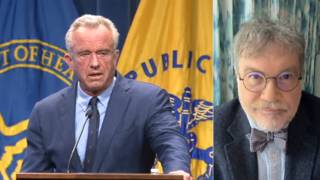
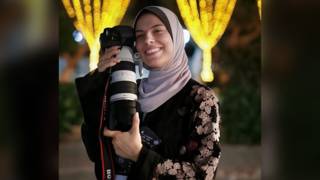
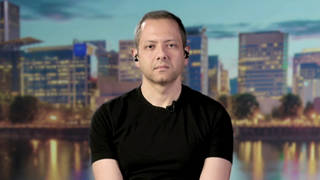
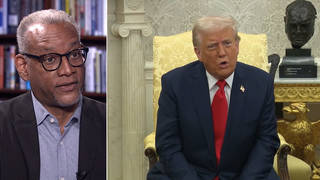
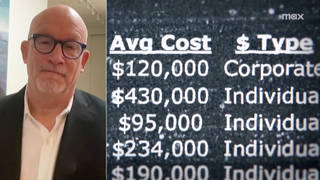
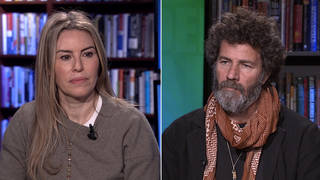
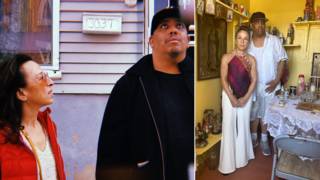


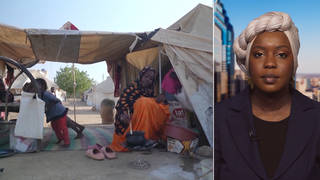
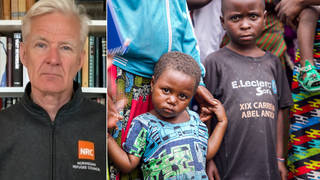
Media Options